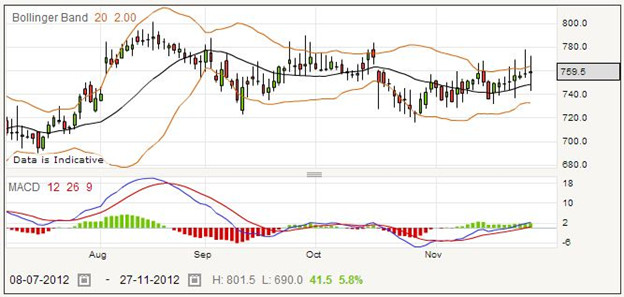Jardine Lloyd Thompson Group, otherwise known as JLT, is a major insurance and employee benefits company. The following daily price chart shows that it may have good volatility for profitable spread betting.

In particular, note that it offers opportunities both up and down, with good consistency to the signals of the MACD indicated below, and that the overall length of the candles to the ends of the wicks shows that prices vary greatly each day.
The Group is one of the largest in the world, and was formed in February 1997 when Jardine Insurance Brokers merged with the Lloyd Thompson Group. The company has partnerships around the world, covering 135 countries. It has grown with strategic acquisitions.
Its business deals with both insurance and re-insurance, which is to do with containing risk by sharing insurance liabilities with other similar companies. In addition, its employee benefits division helps other businesses in planning how best to look after its employees, including pensions, healthcare, investment consulting, SIPPs, and SSASs. It goes without saying that many business owners cannot consider themselves experts in such fields, so JLTs expertise performs a vital function in employee retention.
Note that the Bollinger Bands are well behaved in this chart, defining the boundaries of any moving trends fairly effectively. Some people believe that Bollinger Bands are not working reliably if the price goes beyond them, but in fact the statisticians say that the bands should only contain 95% of the price movement, and they are in any case subject to fluctuations. The width of the bands is a measure of volatility. When the bands narrow it is common to see the price take off in one direction or another, as though it has been squeezed down and contained and therefore has to burst out somewhere. This effect is also noticeable in the chart above.
Jardine Lloyd Thompson Group Rolling Daily: How to Spread Bet on Jardine Lloyd Thompson Group Shares?
The shares of JLT show a great deal of volatility, even though the opening and closing prices are often far closer than the price extremes experienced each day. The current price for a rolling daily bet on JLT is 756.1 – 759.9. If you think that the shares are overbought, and starting to decline in value, you could place a short bet at 756.1, staking perhaps £10 per point.
If you are right, the price may go down to 715.6 – 719.4, and you could close your bet for a profit. Working out how much you have won, from the starting price of 756.1 your bet closed at 719.4, remembering that a short bet closes on the buying or higher price. That means that you gained 756.1-719.4 or 36.7 points. Multiplying by your stake, that amounts to a win of £367.
With financial markets, it is difficult to always predict the correct direction of price movement, and therefore you must be prepared for some of your bets to lose. In this case you might find that the price went up to 783.2 – 787.0, and you would close your bet and cut your losses. The starting price was 756.1, as before, and this time your bet closed at 787.0, giving you a loss of 30.9 points. For your size of wager, this amounts to £309.
Many spread betters use stop loss orders to protect their accounts from suffering too great a loss, usually because they cannot watch the price all day long. The stop loss order requires your broker to close your bet if it reaches a certain level of loss. In this case a stop loss order might have closed your bet after the price went up to 772.0 – 775.8. Your losses this time would be 775.8 minus 756.1, which is 19.7 points, and that would cost you £197.
Jardine Lloyd Thompson Group Futures Style Bet
You have a choice of three different futures style bets on JLT, the near quarter, mid-quarter, and far quarter. The current price for the far quarter bet is 757.6 – 766.8, and it expires in seven months time. If you are bearish in the midterm on this stock, you might choose to go short with a stake of £12 per point.
Suppose the price drops to 714.7 – 725.3, and you decide to collect your winnings. As you placed a sell or short bet, the initial starting price was 757.6 and the closing price was 725.3. If you get confused which of the two prices to use when working out your bets, you simply have to remember that the prices work against you, reducing your profit and increasing your losses. This is not nefarious, simply the reality that your spread betting provider gets paid for his work by taking the “spread”. 757.6 minus 725.3 is 32.3 points, so your winnings would be 32.3 times £12 which is £387.60.
If instead the price went up after you placed your bet, you would need to accept your loss and close the trade before the losses mounted up. Suppose the price went to 775.1 – 784.3. Closing your spread trade at 784.3, and with a starting price of 757.6, you would have lost 26.7 points. For your size of stake that would cost you £320.40.
Using a stop loss order, which you would place when you open the bet, will often save you a little in the unfortunate event that your bet is a loser. As your spread betting provider continually monitors the market, usually he will close your bet with a stop loss order more quickly than you could. This time, the stop loss might end your trade when the price was 769.3 – 777.5. You lost 777.5 minus 757.6 points, which works out to 19.9 points and a loss of £238.80.